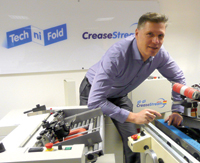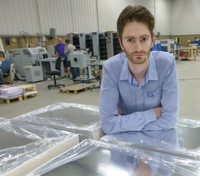Whether his creative juices flowed because he was quaffing a passable German red at the time, we don’t know. The details of precisely how Gutenberg put his revolutionary ideas together are not recorded.
What we do know is that Gutenberg’s method drove a print revolution that helped propagate the Renaissance, no less. And that print innovations have flowed thick and fast ever since
A notable latter-day example is Chester Carlson’s invention of electrophotography, subsequently renamed Xerography, in 1938.
The tenacity required by those in the inventing game is illustrated by the fact that it took Carlson almost a decade to find a company willing to help him to turn his invention into a product. That company was a photographic paper firm called Haloid, subsequently renamed Xerox.
And the spirit of innovation is alive and well in the printing industry to this day. As Tech-ni-fold’s Graham Harris says: “Everyone has an invention in them.” The key thing is to make it happen.
The inveterate inventor
Bruce Podmore, managing director, Windles Group
It’s fair to say that Bruce Podmore’s interest in all things print-related began at a formative age. “When I was five years old I was taken into my grandfather’s print factory and I was transfixed by the colour of the ink,” he recalls. “I’m a mechanically-minded person and have been since I was five or six years old.”
And it has been to Windles’ benefit that Podmore didn’t have to put aside childish things when he himself joined the world of work. “I’ve got the best job in the world, because it ain’t work,” he states. “This is what I do for fun – get a printing press and think, ‘well, I can make a laminator out of this’. It never stops, this process, in my mind.”
He cites the development of cold foiling techniques – known as Foiltone – as his most notable achievement. “It was about how to approach traditional hot foiling in a different way. That’s the most impactful thing,” he explains. “People were saying ‘what’s that idiot in Long Crendon doing?’ Then press manufacturers started getting interested.”
Indeed, Podmore believes that current cold foiling systems on the market have all effectively been spawned from knowledge gained in the Windles factory.
He didn’t stop at cold foiling though. He also worked out how to cast holograms into wet varnish, and various alternative uses for thermography and thermochromic inks.
All these techniques have provided valuable stand-out for Windles’ greetings card customers, in a market where stand-out is everything.
“We try to come up with three or four new ways of doing things every year. We make it our job to ask our customers ‘have you seen this?’ and ‘can you use that?’”
Recent examples of this constant quest for the new and different include glow-in-the-dark age cards and the development of high-raise thermography underpinned with fluorescent inks. “It looks like a stick-on badge, it’s rather a unique look,” reports a clearly delighted Podmore. “We’ve just launched it and had the first jobs running with it pretty much immediately.”
And it’s not just in the press hall that Podmore’s inventive mind comes into its own. Inspired by trips to less well-off countries where “nothing is wasted”, Podmore alighted on a way of disposing more usefully of the two tonnes of wooden pallets the business can end up producing each week.
“We’ve found a way of converting those pallets into fuel. We chip the pallets, press them into briquettes, and use those as fuel cells in our clean air certified wood chip burner. “We can generate 500kWh from this heater and it’s green fuel,” he enthuses, reporting a 26% reduction in heating costs in the burner’s first year of operation.
Indeed the briquette move was part of a raft of measures that helped propel Windles to the top spot as PrintWeek’s reigning Environmental Company of the Year.
And although Podmore describes the firm’s staff as being “very long-suffering” in putting up with some of his flights of fancy, there is a serious business benefit behind it all.
“They realise it makes us different, and that encourages a culture where we’re always thinking of new ways of doing things. Our production manager came up with an idea the other day for a clever way we could potentially use 3D printing. Why not? If we can do it, we should.”
The print finisher who created a global brand
Graham Harris, managing director, Tech-ni-fold
 There is good reason why Graham Harris is something of a poster boy for inventive entrepreneurs up and down the country. The idea he came up with during his lunch breaks working at a Leicester-based printer has gone global – the firm’s Tri-Creaser is now available worldwide via a network of 96 distributors.
There is good reason why Graham Harris is something of a poster boy for inventive entrepreneurs up and down the country. The idea he came up with during his lunch breaks working at a Leicester-based printer has gone global – the firm’s Tri-Creaser is now available worldwide via a network of 96 distributors.
Harris says he has always had “an inventive mind”. “I was at work, and I was thinking about what was the biggest thing people struggle with in finishing, and it’s cracking. There’s often no time to send a job out for creasing.
“I thought that if I could create a device to improve it I could perhaps be a consultant. At the time I had two young kids and not a lot of money. I borrowed £2,000 from my sister and approached some engineers in my dinner break. I knew I needed to use rubber, it was just a question of how.”
While Harris’s wife was working at weekends, he’d be in the garage honing his ideas and enlisting his daughter and son to draw and measure things for him.
His eureka moment came when he was experimenting with rubber O-rings on a shaft, creating creases using a bed of rubber.
“I took the O-ring out and as I did so it flicked into a groove and protruded outward. My heart skipped a beat. I ran that into a channel and got a fantastic crease – the sort of crease I’d only ever seen produced on a platen cylinder before,” he recalls.
The rest, as they say, is history. Tech-ni-fold’s range now spans 400 different products including standalone devices such as desktop creasing machines.
But it wasn’t all plain sailing. His then-boss said Harris “would only make pin money”. And finding a suitable rubber compound proved tricky. “Initially the rubber wasn’t hard-wearing enough. I spoke to a rubber specialist who took me under his wing and mixed up special rubbers. We got to 10,000, 20,000 and then 100,000 runs before it wore out. Now we’re at 800,000 to a million.”
Tenacity and something of a thick skin are an essential part of the inventor’s armoury, says Harris.
“A normal, average person can do great things. But a lot of people fall at the first hurdle. They haven’t got the durability,” he states. “I got a lot of rejections in the beginning. You have to keep at it.”
He’s still having ideas and encouraging the Tech-ni-fold team to do likewise. The firm now employs nine staff at its Leicester base, and has turnover of around £2m.
And what of Harris’ sister and her £2,000? “After I’d sold my first prototypes I was able to pay her back. I remember singing all the way home, and I gave her £500 extra.”
The do things differently printer
Jon Lancaster, managing director, Falkland Press
 No matter what the piece of kit is in Falkland’s factory, Jon Lancaster will want to know exactly how it works and indeed how to run it.
No matter what the piece of kit is in Falkland’s factory, Jon Lancaster will want to know exactly how it works and indeed how to run it.
He says his father, Andy, has always had lots of ideas about different ways to use machines so perhaps it’s in his genes.
“I am very machine focused and spend a lot of time tinkering,” says Lancaster. “I’m interested in putting things together to get a great result or a better product.”
The Letchworth-based firm’s Silverboard metallised packaging board is a case in point.
Lancaster decided to make the board in-house after realising that commercial board products, combined with the digital print click charge, were proving price prohibitive for anything but very low quantities.
“So I either had to buy a UV press or work out a way to save money elsewhere,” he says.
It could be argued that laminating a metallised substrate to a board is theoretically easy-peasy and anyone could do it. That’s the theory. But the reality is somewhat different, as Falkland Press soon found out.
At the beginning of last year, Lancaster made his first batch of sheets and into the firm’s Indigo 5600 they went. “It jammed and the ink stuck to it. So not great!”
Then he made some more. This time it destroyed the blanket.
“The results looked so good, but it just wouldn’t run properly on the Indigo,” he recalls. “I though, ‘oh well, back to proofing quantities’.”
But, being a tenacious type, he simply couldn’t let the idea go so it was back to the (metallised) drawing board once again. “I got some more technical information about materials interaction, and some help. And we tried again.”
It had taken three months, but by April 2013 the firm had the process cracked, and volumes grew and grew.
“It’s been an interesting learning experience and really given me a load of energy. And it’s given us a lift as a company. I enjoy working with HP and my customers on it.”
The next step in the firm’s journey is taking its know-how into B2 format with its newly-installed HP Indigo 10000. Lancaster is one of the first printers in the world to get his hands on the white ink for the press, and it sounds like he’ll be on repeat order when it comes to this particular consumable.
“The sheet size of the 10000 gives us more applications for carton printing. We’ve done 40 pallets of B2 board already.”
So what’s next on his to-do list? Lancaster has only really scratched the surface of potential packaging applications for the firm’s set-up. Digital lenticular is also on his wish-list, but in the meantime the B2 Silverboard work is his main focus: “It is going to give us so much more scope,” he says.








